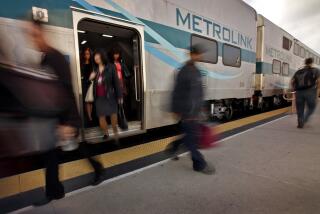2 Die, Hundreds Hurt as Trains Crash Head-On
- Share via
A mile-long freight train traveling east through Orange County failed to stop at a warning light and collided head-on Tuesday morning with a double-deck Metrolink commuter train, killing two people and injuring more than 260.
Either the engineer missed the light or it malfunctioned, the chairwoman of the National Transportation Safety Board said Tuesday night at the scene of the crash. The accident caused the first deaths in the 10-year history of Metrolink, which runs more than 100 trains a day in a network spanning six Southern California counties.
“If the signal was functioning normally, it would have been a red and that [freight] train should have stopped,” said NTSB Chairwoman Marion C. Blakey.
The crash at 8:10 a.m. shook buildings and sent passengers flying through the air in a tumble of newspapers, eyeglasses and seat cushions. After the impact, screaming passengers pounded on the train windows to get out, witnesses said.
“You had no control,” said Brent Belisle, a Metrolink commuter who was on his way from Corona to Anaheim. “It was like surfing in Hawaii when a 30-foot wave hits you.”
The collision occurred in Placentia, about 35 miles southeast of downtown Los Angeles.
Placentia resident Bobby Paredes heard the crash from his home two blocks away.”The thing just shook my whole house,” said Paredes, 38. “I knew it was something major. Nothing has ever shook the house but an earthquake.”
NTSB officials said the southbound Metrolink train, which runs between Riverside and San Juan Capistrano, stopped suddenly because the engineer saw the Burlington Northern Santa Fe freight train approaching on the same track.
An NTSB official, who asked to remain anonymous, said preliminary data showed the freight train had been going about 50 mph. The engineer saw the impending collision and applied the emergency brakes when the trains were 2,100 feet apart, the official said, slowing the freight train to about 23 mph when it hit.
Blakey said the freight train engineer and conductor jumped off the train before it hit the Metrolink train and dragged it 370 feet down the track.
“I was reading my paper and then ‘Boom!’ ” recalled passenger Patrick Madden of Corona. “It was like a big shock wave. Bodies were flying out of their seats. Cushions were flying past.”
The Metrolink train carried about 300 people. In all, 186 were taken to eight hospitals. Orange County fire officials reported that 20 people had suffered critical injuries and 65 were seriously hurt. About 100 people were treated at the scene for minor injuries, mostly bruises, and others may have been injured but left without treatment, authorities said.
None of the four engineers and conductors on the two trains suffered life-threatening injuries, a United Transportation Union official said.
“If they hadn’t gotten the signal to stop,” said Capt. Cliff Schnack of the Orange County Fire Authority, “this could have been a lot worse.”
Witnesses said that after the freight train struck the Metrolink train, snapping it backward, it rammed it a second time as it continued down the track.
“You have the initial impact,” said Charlie Watts, 54, a bus salesman who was traveling from Riverside to Orange. “My first thought was, ‘Hey, I made it.’ And then you get the screams and cries and the second impact. And that’s when it got really scary. It was horrendous. The train caught up with us again. It hit us with the same intensity.”
The nose-to-nose impact bent the front Metrolink car in two and shoved it and the second car partially off the tracks. The train had been powered by a rear locomotive, so the lead car carried passengers, as well as an engineer in a front-facing cab.
At least one of the men who died was in the first car, Orange County sheriff’s spokesman Jim Amormino said. He was identified as Robert Kube, 59, a federal employee who was commuting from his home in Moreno Valley to his office in Santa Ana. The other fatality was a 48-year-old man whose identity was not immediately released.
For a time after the accident, the area around the train--a broad, dusty patch near Richfield Road and East Orangethorpe Avenue--resembled a cross between a refugee camp and an emergency room. Passengers lay on stretchers, tarps or the bare earth near the crumpled train. Many were bleeding and bore expressions of shock or pain. Paramedics applied bandages and neck braces.
“It was an amazing scene, just cell phones and Band-Aids,” said Rick Darden, a Placentia Police Department chaplain. “Just lines and lines of people lying on backboards and tarps, bleeding and bandaged and calling their families on cell phones.”
The passenger train was running on tracks operated by the freight company BNSF.
“This is a shared track,” said Sharon Gavin, a Metrolink spokeswoman. “It’s a track that is owned by Burlington Northern, and they’re the ones who dispatch for this track.”
Although she did not assign responsibility for the accident, she said, “Our train normally runs on this track at this time in this direction.”
A BNSF spokeswoman, Lena Kent, declined to comment on the accident. She said the 67-car freight train, pulled by three locomotives, carried a varied cargo in large shipping containers and was operated by an engineer and a conductor.
It was the second serious train crash in a week for the NTSB. Last Thursday, an Amtrak train derailed in Florida, killing four passengers and injuring more than 160.
Two NTSB investigators arrived at the Placentia crash site about noon Tuesday. They recovered the trains’ event recorders, which keep track of speeds, throttle positions and brake settings, among other things.
NTSB investigators boarded the train late Tuesday, taking pictures and working under bright lights. They inspected the signal system and recovered recordings of the conversations between dispatchers and crew, officials said. The federal agency assigned 14 investigators, who will spend the next several months on the case.
The NTSB began to interview the train crews and will eventually simulate the crash. NTSB investigator Ted Turpin said blood samples of both engineers were taken to test for drugs and alcohol, which is standard procedure in such transportation accidents. The line was expected to remain closed today. Metrolink officials said they would provide bus service for the route.
In a coincidence, the accident was on the morning that many Orange County emergency agencies--police, hospitals, fire departments--were participating in a transportation disaster drill.
The mock crisis involved the fictional crash of a truck carrying hazardous materials in Brea, a neighboring city. Some officials said they believed they were able to react more quickly because of the drill.
“The blessing in all of this is it happens at the same time and in the same area and we were all ready to respond,” said Sandy Scheppmann, spokeswoman for Anaheim General Hospital.
Schnack described what rescuers saw when they entered the lead coach in the train. The fire captain, who supervised the rescue, said the top section of the two-level car was splattered with blood and vomit.
Firefighters had difficulty scaling one stairway because it was so slick with blood, Schnack said. The other staircase had buckled from the impact of the crash, and one man was stuck underneath it. Firefighters eased him out through the window.
In the lower section of the car, eight to 10 more passengers were wounded and unable to leave without help.
Tuesday’s accident occurred less than three years after a similar collision between a passenger and freight train in Orange County.
Nineteen people were injured, boxcars tumbled down an embankment and a locomotive derailed on Nov. 18, 1999, after a Metrolink train slammed into a 38-car Burlington Northern Santa Fe freight train in Fullerton.
“To this date, the investigation has not resulted in any recommendations,” said Jim Southworth, the lead investigator, on Tuesday. NTSB spokesman Keith Holloway said the probe remains open.
*
Contributing to the coverage of the Placentia train crash were Stan Allison, Mike Anton, Tina Borgatta, Darren Briscoe, Tina Dirmann, Janet Eastman, Milton Carrero Galarza, Jessica Garrison, Scott Gold, Jeff Gottlieb, Carla Hall, Evan Halper, Christine Hanley, Mitchell Landsberg, Jack Leonard, William Lobdell, Gariot Louima, Eric Malnic, Scott Martelle, Jennifer Mena, Monte Morin, Sandra Murillo, Dana Parsons, Stuart Pfeifer, Jocelyn Y. Stewart, Kurt Streeter, Mai Tran, Dan Weikel, Phil Willon, Janet Wilson, Nancy Wride, Daniel Yi and Kimi Yoshino.
More to Read
Sign up for Essential California
The most important California stories and recommendations in your inbox every morning.
You may occasionally receive promotional content from the Los Angeles Times.












